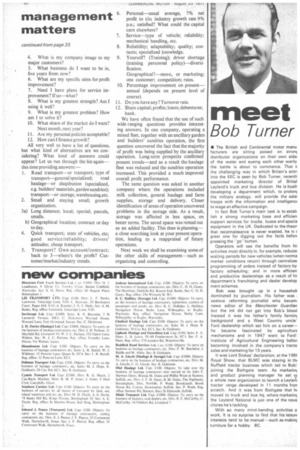management matters
Page 38

If you've noticed an error in this article please click here to report it so we can fix it.
continued from page 35
4. What is my company image to my major customers?
5. What business do I want to be in, five years from now?
6. What are my specific aims for profit improvement?
7. Need I have plans for service improvement? If so-what?
8. What is my greatest strength? Am I using it well?
9. What is my greatest problem? How am I to solve it?
10. What share of the market do I want? Next month, next year?
11. Are my personal policies acceptable?
12. How can I finance growth?
All very well to have a list of questions, but what kind of alternatives are we considering? What kind of answers could appear? Let us run through the list againthis time providing answers: 1. Road transport-or transport; type of transport-general/specialized; road haulage-or distribution (specialized, e.g. builders' materials, garden sundries); transport-or storage, warehousing,etc.
2. Small and staying small; growth organization.
3a) Long distance; local; special; parcels, smalls.
b) Geographical location; contract or day to day.
4. Quick transport; state of vehicles, etc; good service/reliability; drivers' attitudes; cheap transport.
5. Transport? Own-account/contract; back to 3-where's the profit? Customer/market/industry trends. 6. Personal-usual average, 7% net profit to t/o; industry growth rate 9% p.a.; satisfied? What could the capital earn elsewhere?
7. Service-type of vehicle; reliability; mechanical handling, etc.
8. Reliability; adaptability; quality; contacts; specialized knowledge.
9. Yourself? (Training); driver shortage (training personnel policy)-diversification.
Geographical?-move, or marketing; one customer; competition; rates.
10. Percentage improvement on presentannual (depends on present level of course).
11. Do you have any? Turnover rate.
12. Share capital; profits; loans; debentures; bank.
We have often found that the use of such wide-ranging questions provides interesting answers. In one company, operating a mixed fleet, together with an ancillary garden and builders' sundries operation, the first question uncovered the fact that the majority of profit was being supplied by the ancillary operation. Long-term prospects confirmed present trends-and as a result the haulage fleet was reduced and the sundries operation increased. This provided a much improved overall profit performance.
The same question was asked in another company where the operations included milk collection, general haulage and farm supplies, storage and delivery. Closer identification of areas of operation uncovered problems in the storage side. As a result, storage was affected in less space, on better terms. The saved space was rented out as an added facility. This then is planninga close searching look at your present operation, leading to a reappraisal of future operations.
Next week we shall be examining some of the other skills of management-such as organizing and controlling.




















































































